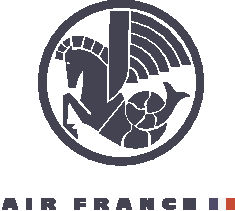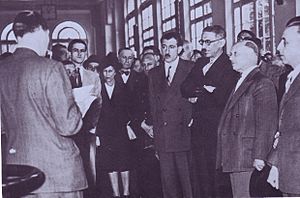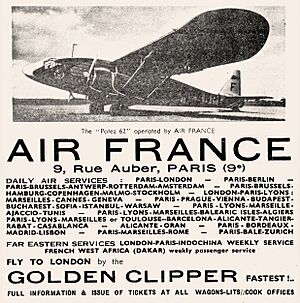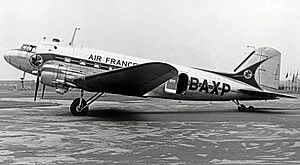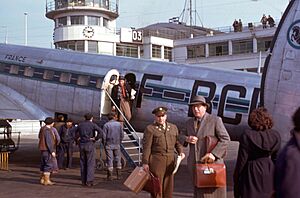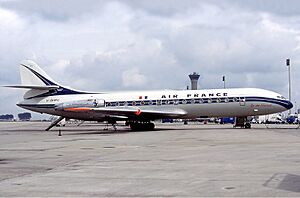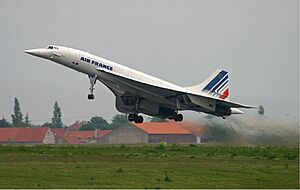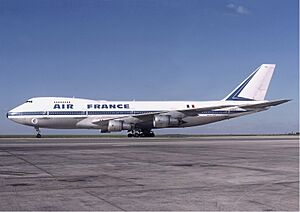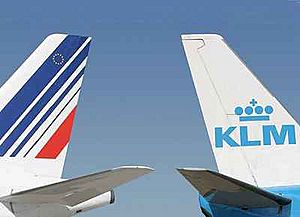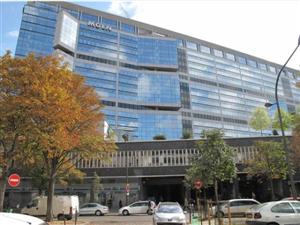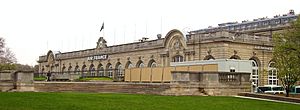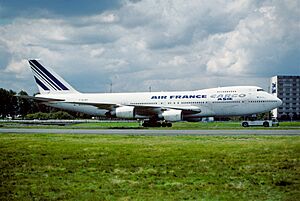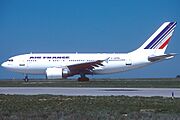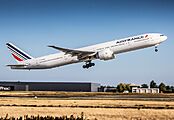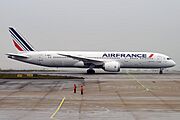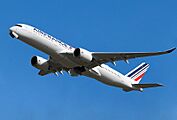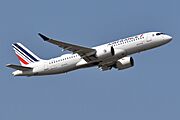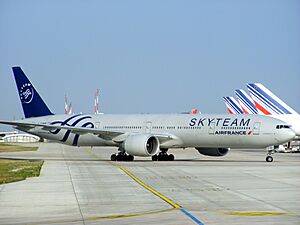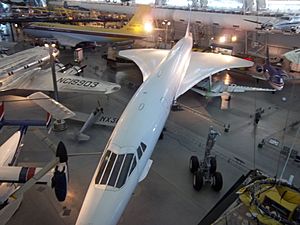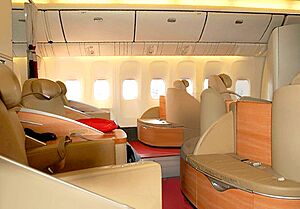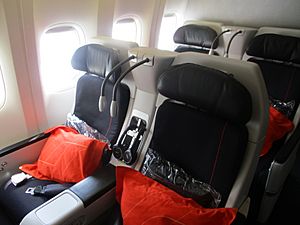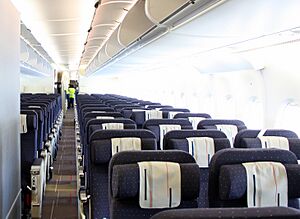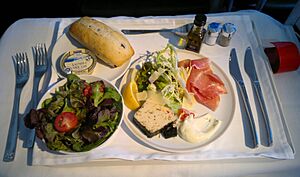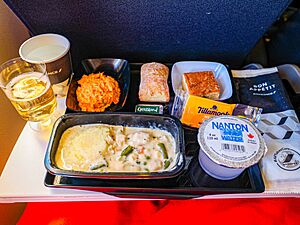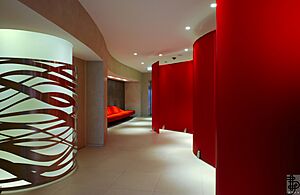Air France facts for kids
An Air France Airbus A350-900
|
|
| Founded | October 10, 1909 (as Compagnie générale transaérienne) |
|---|---|
| Commenced operations | 30 August 1933 (as Air France) |
| Hubs | |
| Focus cities |
|
| Frequent-flyer program | Flying Blue |
| Alliance | SkyTeam |
| Subsidiaries |
|
| Fleet size | 228 |
| Destinations | 184 |
| Parent company | Air France-KLM |
| Headquarters | Roissypôle, CDG Airport, Tremblay-en-France, France |
| Key people |
|
| Revenue | €16.3 billion (2022) |
| Operating income | €483 million (2022) |
| Employees | 38,000 |
Air France is a major airline from France. It's known as the country's flag carrier, meaning it's the main airline representing France around the world. Its main office is in Tremblay-en-France, near Paris. Air France is part of the Air France-KLM Group and was one of the first airlines to join the SkyTeam alliance.
By 2013, Air France flew to 29 places in France and 201 destinations in 78 countries globally. In 2019, it carried over 46 million passengers! The airline's main hub, or central airport, is Charles de Gaulle Airport in Paris. Orly Airport is its main hub for flights within France.
Air France started way back in 1909 with an early airline company. The name "Air France" officially began on August 30, 1933. This happened when several smaller French airlines merged together. For many years, it was France's main national airline until it joined with KLM in 2003.
In 2018, Air France and its regional airline, Air France Hop, carried 51.4 million passengers. Air France uses a mix of Airbus and Boeing planes for long flights and Airbus A320 family planes for shorter trips. Air France was one of the first airlines to use the Airbus A380 in 2009.
History of Air France
How Air France Began
Air France's story goes back to 1909 with a company called Compagnie générale transaérienne. Air France itself was formed on August 30, 1933. It was created by combining five different airlines: Air Orient, Air Union, Compagnie Générale Aéropostale, Compagnie Internationale de Navigation Aérienne (CIDNA), and Société Générale de Transport Aérien (SGTA).
SGTA was France's very first airline for passengers. It started weekly flights between Paris and Brussels in March 1919. This was the world's first international commercial flight! These early airlines built large networks across Europe and to French colonies. During World War II, Air France moved its operations to Casablanca, Morocco.
In 1936, Air France added French-built Potez 62 planes to its fleet. These planes could carry 14 to 16 passengers. They were used for flights in Europe, South America, and the Far East. Even though they flew at only 175 miles per hour, the Potez 62 was a strong and dependable plane for Air France.
On June 26, 1945, the French government took control of all French air transport companies. Air France was given the job of managing the entire French air network. In 1946, Air France hired its first flight attendants. That same year, the airline opened its first air terminal in central Paris at Les Invalides.
By July 1, 1946, Air France began direct flights between Paris and New York. These flights made stops in Shannon, Ireland, and Gander, Canada. Douglas DC-4 planes completed the trip in just under 20 hours. By September 1947, Air France's network stretched from New York to Shanghai.
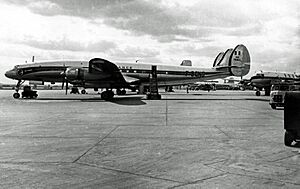
By 1948, Air France had 130 aircraft, making it one of the largest fleets in the world. From 1947 to 1965, the airline used Lockheed Constellation planes for passengers and cargo. On June 16, 1948, the company "Compagnie Nationale Air France" was created. The government owned most of it.
In 1949, Air France helped start SITA, a company that provides telecommunications services for airlines.
The Jet Age Begins
In 1952, Air France moved its main operations to the new Orly Airport South terminal. Air France entered the jet age in August 1953. It began flying the de Havilland Comet jet on the Paris-Rome-Beirut route.
In the mid-1950s, it also used Vickers Viscount turboprop planes for European routes. In 1960, Air France started regular jet flights with the Sud Aviation Caravelle and the Boeing 707. These jet planes cut travel times in half and made flights much more comfortable. Air France later became one of the first airlines to use the Boeing 747 and eventually had one of the largest 747 fleets in the world.
In 1974, Air France started moving most of its flights to the new Charles de Gaulle Airport north of Paris. Air France also became the first airline in the world to operate the Airbus A300, which was Airbus's first commercial plane.
Supersonic Concorde Service
On January 21, 1976, Air France began its first supersonic transport (SST) flights with the Concorde. These flights went from Paris (Charles de Gaulle) to Rio de Janeiro, Brazil, with a stop in Dakar, Senegal. Supersonic flights to Washington Dulles Airport in the US began in May 1976.
Flights to New York (JFK) started in November 1977. The trip from Paris to New York took only 3 hours and 23 minutes, flying at about twice the speed of sound. Air France was one of only two airlines (the other being British Airways) to regularly fly supersonic services. It continued daily Concorde flights across the Atlantic until May 2003.
By 1983, Air France was celebrating its 50th birthday. It had over 34,000 employees and a fleet of about 100 jet planes, including 33 Boeing 747s. Its network covered 634,400 kilometers and served 150 destinations in 73 countries. This made Air France the fourth-largest passenger airline in the world.
In 1987, Air France, along with Lufthansa, Iberia, and SAS, helped create Amadeus. This is a company that helps travel agencies sell airline tickets from one system. In 1988, Air France was one of the first airlines to receive the Airbus A320 plane. It was also one of the first to use the A320 for short flights.
Mergers and Changes
On January 12, 1990, Air France merged with two other French airlines: Air Inter and UTA (Union de Transports Aériens). This merger made Air France much larger. The government wanted to create one big national airline to compete better in Europe.
In 1999, the French government allowed Air France to become partly private. Its shares were listed on the Paris stock exchange. In June 1999, Air France and Delta Air Lines started working together on transatlantic flights. This partnership grew into the SkyTeam global airline alliance in June 2000.
Air France–KLM Group
On September 30, 2003, Air France and Netherlands-based KLM Royal Dutch Airlines announced they would merge. The new company was named Air France–KLM. The merger officially happened on May 5, 2004. This made Air France–KLM one of the largest airlines in the world.
Even though they are owned by the same company, Air France and KLM still fly under their own names. Air France–KLM remained part of the SkyTeam alliance. By March 2007, the group employed over 102,000 people.
In 2012, Air France-KLM announced a plan called "Transform 2015" to help the airline become profitable again. This plan involved cutting costs and changing how short and medium flights operated. The goal was to make Air France-KLM a major global airline by 2015.
In September 2013, Air France introduced new and improved seats for its Economy and Premium Economy cabins. In 2014, the airline announced it would stop transporting nonhuman primates for research.
In late 2015, Air France faced some financial challenges, made worse by a pilot strike. The airline announced it would cut about 2,900 jobs. In December 2015, Air France announced that its last Boeing 747-400 would retire in January 2016. The airline had flown the 747 since 1970.
In January 2017, Air France received its first Boeing 787–9. In July 2017, Air France-KLM formed a big partnership with Delta Air Lines, China Eastern Airlines, and Virgin Atlantic. This strengthened the connections between these airlines. In December 2018, Anne Rigail became the Executive Director of Air France.
Air France Offices
Head Office
Air France's main office is in the Roissypôle complex at Charles de Gaulle Airport in Tremblay-en-France, near Paris. This large building was finished in December 1995. The airport runways can be seen from the building. The Air France Operations Control Centre, which manages all Air France flights worldwide, is also located here.
Before 1995, Air France's headquarters were in a tall building next to the Gare Montparnasse train station in Paris.
Vaccination Centre
Air France runs the Air France Vaccinations Center in Paris. This center provides vaccines for people traveling internationally. Since 2001, it has been the only French vaccination center with a special quality certification (ISO 9001).
Aérogare des Invalides
The Aérogare des Invalides building in Paris has an Air France agency and the Air France Museum. It used to host the Air France Vaccinations Centre until 2005.
Air France Subsidiaries
Air France has several smaller companies that are part of its group:
- Transavia France
- Air France Hop (formerly HOP!)
- Servair
Air France and the Dutch airline Transavia created Transavia France in May 2007. This is a low-cost airline based at Orly Airport.
Air France Asie
Because of the special situation with Taiwan, Air France could not fly to the island under its own name. So, in 1993, it created a special airline called Air France Asie. This airline flew between Paris and Taipei. Its planes had blue and white stripes on the tail instead of the usual French colors. Air France Asie stopped flying in 2004.
Aircraft Colors and Design
Air France planes today are mostly white with the blue "Air France" name and design. The tail is white with slanted red and blue lines, and a small European flag at the top. This design has been used since the late 1970s.
In January 2009, Air France introduced a new logo and a slightly changed design for its planes. The tail now has three blue bars that curve at the bottom. In 2019, with the arrival of the Airbus A350, Air France updated the design again. It brought back the tradition of naming each plane, with the name written under the front windows. The first A350-900 was named after the city of Toulouse.
-
Air France Airbus A310 in the 1976 design
-
Air France Boeing 777 in the 2009 design
-
Air France Boeing 787 in the 2017 updated design
-
Air France Airbus A350 in the 2019 updated design
Uniforms
Air France flight attendants wear uniforms designed by French fashion designer Christian Lacroix. The uniforms show rank: senior Pursers have two silver stripes on their sleeves, while Pursers have one. Flight attendants do not have stripes.
Air France Logo
When it was formed, Air France adopted the seahorse logo from its earlier airline, Air Orient. This logo is called the hippocampe ailé, which means "winged seahorse." It used to be on the nose of the planes. After the merger with KLM, the Air France-KLM logo went on the nose, and the seahorse moved to the engine covers. On January 7, 2009, Air France officially changed its logo to a red stripe.
Where Air France Flies
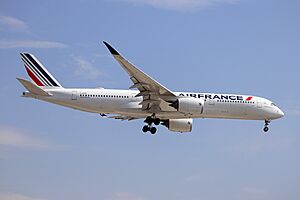
Air France flies to 29 places within France and 201 international destinations in 94 countries. This includes flights by its cargo service and partner airlines. Most of Air France's international flights leave from Paris-Charles de Gaulle Airport. Air France also has a strong presence at Paris-Orly, Lyon-Saint-Exupéry, Marseille Provence, Toulouse Blagnac, and Nice Côte d'Azur airports.
Main Hubs
- Charles de Gaulle Airport: This is Air France's biggest hub for flights all over the world. It has 335 flights leaving every day. It's also a hub for Air France's partner airline, Air France HOP.
- Orly Airport: This is Air France's second biggest base. It's also the main hub for Air France's partner airline, Transavia France.
Partner Airlines
Air France works with many other airlines through "codeshare agreements." This means they sell tickets on each other's flights. Some of these partners include:
- Aerolíneas Argentinas
- Aeroméxico
- Air Europa
- Air Mauritius
- Air Serbia
- Air Tahiti Nui
- airBaltic
- Austrian Airlines
- China Eastern Airlines
- China Southern Airlines
- Delta Air Lines
- Finnair
- Garuda Indonesia
- Japan Airlines
- Kenya Airways
- KLM
- Korean Air
- LATAM Brasil
- Luxair
- Middle East Airlines
- Qantas
- Saudia
- Scandinavian Airlines
- Singapore Airlines
- Swiss International Air Lines
- TAROM
- Vietnam Airlines
- Virgin Atlantic
- WestJet
Air France Fleet
Air France uses a variety of planes for its flights.
Widebody Planes
These are the large planes used for long-distance flights. Air France-KLM ordered 50 Airbus A350s and Boeing 787s. Air France is the main operator of the Airbus A350, and KLM operates the Boeing 787. The first Airbus A350-900 was delivered to Air France on September 27, 2019.
Narrowbody Planes
These are smaller planes used for shorter flights. Air France uses all four types of the Airbus A320 family planes, with a total of 114 jets. The older Airbus A318 and A319 planes are being replaced by 60 Airbus A220-300s, starting in 2021. Air France plans to use more Airbus A220s for flights within France to help reduce emissions.
Concorde Planes
Air France retired its five Concorde planes on May 31, 2003. This decision was made because there wasn't enough demand for the flights after a Concorde crash in 2000, and because of high fuel and maintenance costs. One Air France Concorde, F-BVFA, is now at the Steven F. Udvar-Hazy Center in Virginia, USA. Another, F-BVFB, is at a museum in Germany.
Boeing 747 Planes
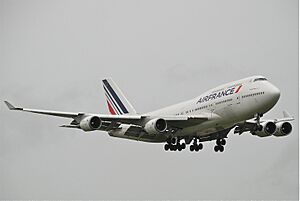
Air France started flying the Boeing 747 on June 3, 1970. It used several different versions of the 747 over the years. In January 2016, Air France finally retired its last Boeing 747–400. These planes were replaced by the Airbus A380s and Boeing 777-300ERs.
Air France Cabins
Air France offers different seating options on its planes for international long-haul flights. These include La Première (First Class), Business Class, Premium Economy, and Economy Class. All long-haul planes have personal screens with movies, TV shows, and games. European short and medium flights have Business, Premium Economy, and Economy cabins.
La Première (First Class)
La Première is Air France's top-tier first class for long flights. It's available on some Boeing 777-300ER planes. The seats are made of wood and leather and can recline completely flat into a two-meter-long bed. Each seat has a touchscreen, privacy divider, massage feature, and charging ports. Passengers get special blankets, pillows, and a travel kit. Meals are designed by famous chef Guy Martin. Passengers also get private lounge access and a chauffeured car to the plane. A new version of La Première was introduced in March 2025 on Boeing 777-300ERs, offering a private suite with five windows and a large bed.
Business Class
Business Class is available on all long-haul planes. The seats recline almost flat into two-meter-long beds. Each seat has a touchscreen TV, reading light, phone, and charging ports. Meals include three courses and a cheese service.
The current Business Class seats were designed by Mark Collins and Brandimage. They started appearing on Boeing 777s in June 2014. These new seats are arranged in a 1-2-1 layout, meaning every passenger has direct aisle access. The seats turn into a fully flat bed and have a 16-inch screen with over 1,000 hours of entertainment.
Premium Economy
Premium Economy is available on all long-haul flights. This cabin first appeared in late 2009. It's a separate section with more space than Economy. The seats have a 38-inch pitch (distance between seats) and recline 123 degrees. They include an adjustable headrest, a 10.4-inch touchscreen, reading lamp, and power ports. Passengers get more baggage allowance, priority airport services, and extra frequent flyer miles. On board, they receive noise-cancelling headphones, an amenity kit, better blankets, and an improved meal service.
Economy Class
Air France's Economy Class for long-haul flights has seats that recline up to 118 degrees. These seats have winged headrests, a personal phone, and a touchscreen TV with entertainment. On long flights, passengers get a choice of two meals. For short and medium flights, Airbus A320 family planes are used with different seating. Air France offers free alcoholic drinks, including champagne, on all flights.
Air France introduced a new Economy product starting in June 2014. These new slimline seats offer more legroom, a wider table, and universal electrical sockets. They also have high-definition 10-inch screens with a USB port and headphones holder.
Services on Board
Food and Drinks
For La Première (First Class), the menu is designed by Guy Martin, a famous chef from Paris. Meals include appetizers, main courses, bread, cheeses, and a dessert cart. On long-haul flights, Air France also serves complimentary champagne and wine to passengers in all classes.
Entertainment
Air France offers movies, TV shows, music, and games on demand in all cabins on long-haul flights. The airline's magazine, Air France Magazine, is available at each seat. Air France Madame, a fashion magazine, is available in La Première and Business cabins and lounges. Most films can be watched in English, Spanish, and French. Some films are also available in Chinese, Japanese, Hindi, and Korean.
In May 2013, Air France started testing Wi-Fi on some of its planes. Passengers can use Wi-Fi on their phones, laptops, or tablets once the plane reaches 20,000 feet.
Le Salon (Lounges)
Air France lounges are called Le Salon. They are open to La Première and Business Class passengers, as well as members of the Flying Blue Gold, Flying Blue Platinum, and SkyTeam Elite Plus programs. There are 530 Air France and SkyTeam lounges in 300 airports around the world.
Flying Blue Program
Flying Blue is the frequent flyer program for Air France-KLM. Members earn points based on how many miles they fly and their class of service. The program has different levels: Explorer, Elite (Silver), and Elite Plus (Gold and Platinum). Elite status is earned by collecting a certain number of Experience Points (XP) in one year. There is also a special invitation-only card called Club 2000 for VIPs.
Awards and Recognition
On June 24, 2024, Air France received several top awards from Skytrax. It was voted World's Best First Class Catering, Best Airline in Western Europe, and Best First Class Lounge Dining.
Incidents and Accidents
Air France has been involved in some major incidents. The most serious accident happened on June 1, 2009, when Air France Flight 447, an Airbus A330-203, crashed into the Atlantic Ocean. All 228 people on board were lost.
Another notable event occurred on July 25, 2000, when Air France Flight 4590, a Concorde, caught fire shortly after takeoff. This was caused by metal debris on the runway damaging a tire, which then caused damage to a fuel tank. The fire led to the aircraft crashing into a hotel near Charles de Gaulle Airport. All 109 people on board, and four people on the ground, were lost.
See also
 In Spanish: Air France para niños
In Spanish: Air France para niños
- List of airlines of France
- List of airports in France
- Transport in France


